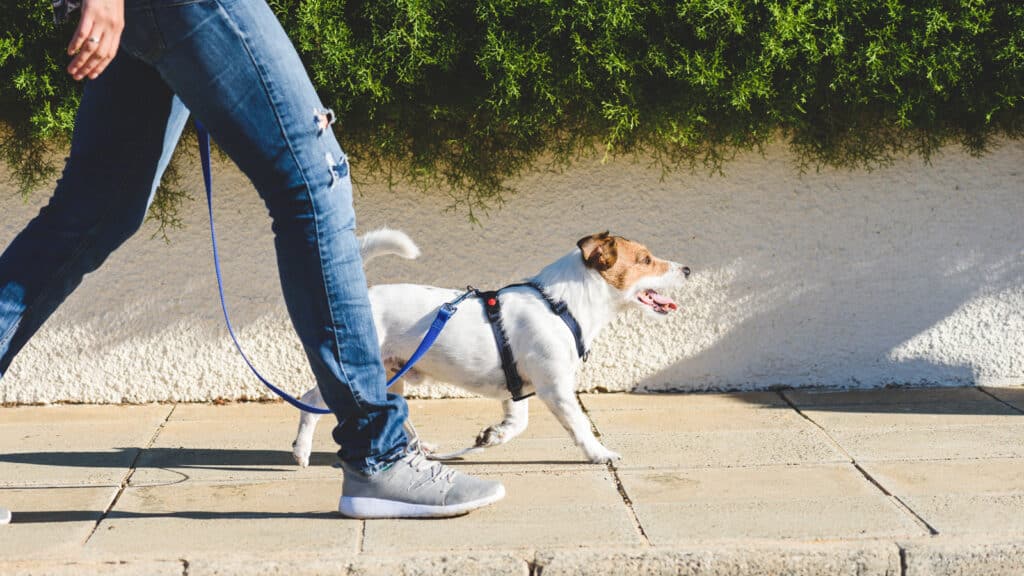How To Lose Weight Walking 2 Miles A Day
Walking is the simplest and most accessible form of exercise. It’s low impact, easy on the joints and you don’t need any special equipment – just a good pair of walking shoes or trainers. Most people can fit 30-40 minutes of exercise into their daily routine – enough to walk 2 miles. But what are the benefits of walking 2 miles a day and is it enough to lose weight?

Can Walking 2 Miles A Day Help You Lose Weight?
Let’s face it, most of us are carrying a little extra body weight. Losing weight just by dieting is hard work and a quick-fix fad diet rarely works – or if it does, as soon as you go back to your old eating habits, the weight piles back on.
Hitting and maintaining weight loss goals comes from making small positive lifestyle changes. Permanent changes. And walking 2 miles a day is a great way to start.
Most people will lose weight by walking 2 miles a day. Walking two miles at a brisk pace burns around 160 to 200 calories. This adds up to losing one to two pounds a month. You’ll lose more weight if you’re heavier, walk at a faster pace, or up hills. For best results combine walking with improving your diet.
A weight loss of one to two pounds a month may not sound very much. It may sound like it’s going to take a long time to lose weight. But think about it! That’s 12 to 24 pounds a year without dieting! I’m sure your weight gain didn’t happen overnight – so be patient. With time the weight loss will show and you’ll love the results.
Walking for weight loss has so many benefits from improving your mood to helping you sleep better. It’s a lot easier to follow a healthy diet when you’re feeling fit and upbeat. Just small changes to your diet combined with walking 2 miles a day could be enough to lose one to two pounds a week.

How Much Weight Can I Lose Walking 2 Miles A Day?
In theory, losing weight is just simple math. You need a calorie deficit. A deficit of 3500 calories to burn one pound of fat. If you want to lose one pound a week just by walking you’d need to walk 5 miles a day. That’s too much for someone who’s completely unused to exercise.
The good news is that when you first start walking every day, most people can get the same results just from walking 2 miles a day.
Why? Because when you’re not used to walking or any exercise your body has to walk a lot harder. My Fat Buster Walking Challenge starts off really easy with a walking distance of just 1-2 miles a day for the first 3 weeks. It’s a level of walking anyone can manage. A great first step – making a real change to your overall health. Follow this free walking for weight loss schedule and build up to walking 5 miles a day by the end of the 9-week program. Most people lose at least 10 pounds.
If you want to lose a pound a week but only have time to walk 2 miles a day, you need to make those 2 miles count – and make small improvements to your diet.
As you get fitter, make the 2 miles more challenging. Walk upstairs or up hills, and go for a brisk walk as fast as possible to hit maximum calorie burn. You could even walk wearing a backpack or even a weighted vest. Anything that makes the walking just a bit harder.
It’s small changes and consistency that will make a difference when it comes to weight loss. It’s better to commit to a daily routine of walking 2 miles than go for a long walk one day and take the rest of the week off.
Related post: Walking For Weight Loss Plan – Fat Busting Workout Schedule
How Many Calories Does Walking Two Miles A Day Burn?
Walking regularly is the easiest way to lose weight – provided you don’t replace the number of calories you burn with high-calorie treats. Walk two miles then eat a chocolate brownie and those extra calories will wipe out all the fat-busting benefits of exercising. The exercise will still be good for you – and good for your heart health, but you’ll struggle to lose weight and could even find yourself gaining extra weight! Walking every day isn’t an excuse to increase your calorie intake if you’re trying to lose weight.
One of the good things I find with walking, compared with running for weight loss, is you don’t get so hungry. It’s easier to balance exercise with eating better. And if you do find your appetite increasing with the extra physical activity, fill up on low-fat whole grains that will keep you full for longer instead of reaching for high-fat sugary treats. Rice dishes are great!
How Many Calories Are Burned Walking 2 Miles?
So how many calories will you burn walking 2 miles? Well, it depends…
Your current weight, gender, how fast you walk and your current fitness level will all affect how many calories you burn on your daily walk. So will walking up steep hills or up steps versus along the flat or making walking harder by carrying weights.
This table estimates calories burned for the average person based on your current weight and walking pace:
Calories Burned Walking 2 Miles Based On Body Weight
| Weight (lbs) | Typical Walking Pace 2.5 mph – 3.5 mph | Brisk Pace 4 mph | Vigorous Pace 4.5 mph | Power Walking 5 mph |
| 100 | 112 | 120 | 148 | 158 |
| 120 | 134 | 142 | 178 | 190 |
| 140 | 156 | 166 | 208 | 222 |
| 160 | 178 | 190 | 238 | 252 |
| 180 | 200 | 214 | 266 | 284 |
| 200 | 222 | 238 | 296 | 316 |
| 220 | 244 | 262 | 326 | 348 |
| 240 | 266 | 283 | 356 | 380 |
| 260 | 288 | 310 | 386 | 412 |
| 280 | 312 | 334 | 414 | 442 |
| 300 | 334 | 358 | 444 | 474 |
Alternatively, use our walking calories calculator to find calories burned walking 2 miles based on weight, time, and walking pace.
Related post: How To Start A Walking Program For Beginners

What Does Walking Do For Your Body?
The benefits of walking are huge. Our bodies are designed to move and one of the best ways is walking. There are even studies showing fast walkers live longer!
Don’t take my word for it! These are the American Physical Activity Guidelines:
“For substantial health benefits, adults should do at least 150 minutes (2 hours and 30 minutes) to 300 minutes (5 hours) a week of moderate-intensity, or 75 minutes (1 hour and 15 minutes) to 150 minutes (2 hours and 30 minutes) a week of vigorous-intensity aerobic physical activity, or an equivalent combination of moderate- and vigorous-intensity aerobic activity. Preferably, aerobic activity should be spread throughout the week.”
Regular walking at a brisk pace can help to:
- reduce the risk of heart disease and improve cardiovascular fitness
- lower cholesterol levels
- reduce blood pressure
- improve blood sugar control in people with type II diabetes
- maintain a healthy weight
- strengthen bones and muscles
- improve balance and coordination
- lift your mood, help you sleep better, and reduce stress.
Most guides talk about the physical benefits of walking but the mental health benefits are just as important. After a difficult day at work, going for a walk in nature is an ideal way to unwind and get a sense of perspective of whatever is worrying you. I get my best ideas when I’m walking and it always helps me sleep better!
Related post: Walking For Weight Loss: Everything You Need To Know
Will You Lose Belly Fat?
There’s an idea in the fitness industry that you can reduce fat in certain parts of your body with specific exercises – it’s a myth. Stomach crunches may help to make your abdominal muscles stronger and those extra muscles may help with fat loss – but you can’t spot reduce body fat.
The good news is that the dangerous visceral fat that sits around your waistline is the first fat store to be depleted when you start to lose weight. Walking may not get rid of all the wobbly bits – if you want to have a “perfect physique” combine walking with strength training in the gym. But for most of us, who just want to look a bit better and be a bit fitter, walking can get rid of that visceral fat around your belly and keep your doctor happy. Find out more with this guide to Will Running Burn Belly Fat Fast – it’s just as relevant for walking.
How Long Does It Take To Walk 2 Miles?
The time it takes to walk 2 miles really depends on your fitness level. For most people, it takes from 30 minutes of walking to 40 minutes to walk 2 miles on the flat. Find out more about how long does it take to walk 2 miles at different speeds
Aim to walk at a brisk pace that increases your heart rate. Don’t worry about how fast other people walk, It’s important to walk at a pace you can maintain.
You want to raise your heart rate but not walk so fast that you’re getting out of breath or sending your heart rate soaring to dangerous levels. Be sensible. If you haven’t exercised in a long time or if you have a very high BMI, check in with your doctor first. It could be a good idea to wear a heart rate monitor to make sure your pace isn’t excessively fast.
How Many Steps?
To accurately measure distance, you need a GPS tracker but a simple step counter is an easy way to keep track of your walking activity. Two miles is approximately 4000 to 5000 steps. If you build up to walking 10,000 steps a day – even better!
It varies from person to person but mainly depends on your height and pace. This guide How Many Steps In One Mile Walking will help you get a better estimate.

Do I Need To Diet If I’m Walking 2 Miles A Day?
The key to weight loss is small achievable changes that become lifelong habits. You’re slowly building a healthy lifestyle not trying to change everything at once.
Start off with walking 2 miles a day – you may find that’s enough to lose extra weight. When daily walking becomes routine, start making some other small changes.
Cut out sugary drinks or cut down on the number of cookies and chips you eat. Which foods are the main cause of your weight gain over the years? Your Achilles heel? It’s different for everyone.
To lose weight you need to build a calorie deficit. It doesn’t mean you have to deprive yourself of all the foods you love – just eat less. Try and eat more healthy foods and eat smaller portions.
For more advice read these articles:
- 32 Healthy Eating Hacks To Eat Better
- Is Diet More Important Than Exercise (When You Want To Lose Weight)
- Why Diets Don’t Work (7 Reasons To Ditch The Diets)
- Why Your Weight Loss Is Slow (And What To Do About It)
How To Lose Weight Walking 2 Miles A Day
- If you haven’t exercised in a long time or have a very high BMI check in with your doctor first.
- Make sure you have comfortable walking shoes or trainers – getting blisters can jeopardize your exercise regime.
- Use a step counter or GPS tracker to measure distance.
- Set off at a brisk walking pace. Aim for a pace that elevates your heart rate but it needs to be a pace you can maintain. As a guide, you should be able to talk as you walk.
- Walk regularly – aim to walk 2 miles EVERY day. It’s better to be consistent if you want to improve your health.
- Make the walking more challenging by adding hills or increasing your pace.
- Try not to eat more calories if walking makes you hungry. Make simple food swaps of high-fat high-sugar junk food for lower-calorie filling whole foods. Build healthy habits by eating more fruit, vegetables, whole grains, and lean protein.
- Look for opportunities to incorporate walking into your everyday life. Walk in your lunch break, always take the stairs instead of the lift, and leave the car at home when you’re popping to the corner shop. Take every opportunity to walk extra steps!
- Walk with friends or walk in nature to make your daily walk more enjoyable.
- Schedule your walking routine into your daily plans and make it a priority. You owe this to your body! Your daily calorie burn is important for your health.
- The more you walk the easier it will get as you get fitter and healthier. Walking is a good way to ease into running – maybe by next year you’ll be running every day!
Find out more about walking for weight loss with my 30 Day Walking Challenge! Or if you want to push yourself a little harder, try walking 3 miles a day!





